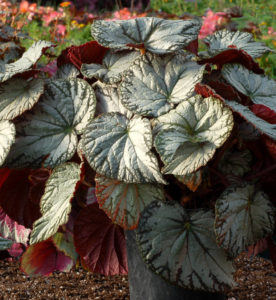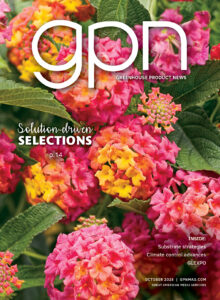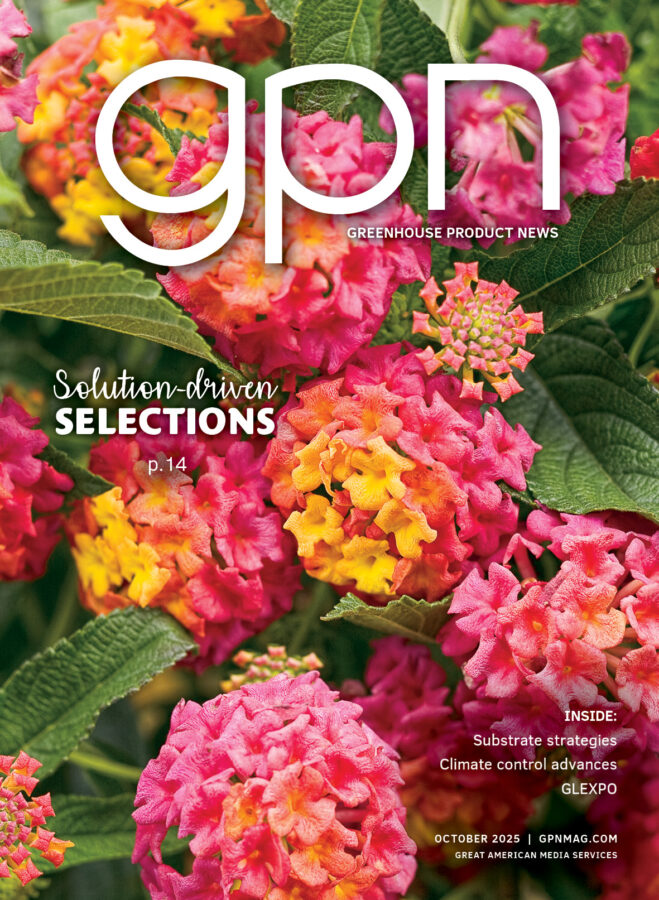
Culture Report: Begonia Silver and T-Rex Series
About 10 years ago, Terra Nova Nurseries embarked on a breeding program that would effectively end its propagation of open market varieties and switch to proprietary, protectable, cutting-edge breeding. The company examined what was lacking in the current offerings and what could be done to improve them. The Terra Nova breeders then came up with a few goals, made a plan and started sourcing the best species they could find to accomplish their stated goals. The company’s close association with begonia enthusiasts and the Begonia Society helped achieve its target.
SILVER SERIES
The begonia SILVER Series came out of the desire to make the best, most hardy group of perennial begonias possible. Terra Nova sourced the hardiest begonia known from a USDA Zone 5 garden in Western New York. Seed was sent from a

population that lived for 20 years or more without care or winter mulching, and thrived during the hot, sticky summers. Crosses were made with a newly discovered, high-elevation tropical species known to be cold tolerant and highly ornamental. Several generations later and, after extensive trialing, ‘SILVER Treasure’ and ‘SILVER Lace’ were released to the public. Both varieties are remarkably easy to grow, with very good consumer appeal.
Propagation. Terra Nova offers liners grown from lab stock free of both Xanthomonas and viruses. Cutting grown material can be a risky venture, and with a tightening of biosecurity, the company feels this is the best choice in propagation. The price of tissue culture (TC) has dropped in recent years, which makes it an affordable alternative to cutting propagation.
Finish Times. From a finished plug, both varieties will finish a 4-inch pot in four to six weeks and a gallon in eight to 10 weeks. It is recommended that liner not be placed directly into gallon containers, but rather be transferred to a 4-inch pot, then a gallon to finish. The SILVER series can be grown cooler than typical begonias, but has also taken heat extremely well, as witnessed at the University of Georgia trials in hanging baskets. Optimal temperatures are between 55 and 75° F with typical begonia shade.
Media and Fertilization. A well-drained potting mix consisting of peat or cocoa fiber, perlite or pumice, and finely ground bark works well for these types of begonias. Fertigate at 150 to 200 ppm of typical bedding plant fertilizer. Once established, they benefit from a small amount of slow-release fertilizer. The EC has a moderate range of 1.2 to 2.4.
Pinching and Growth Regulators. None required. The SILVER series branches well from the base and is compact growing.
Pests and Diseases. Fungus gnats can be a problem in sodden soils, so watch watering and let dry slightly to avoid infestations. Slugs and snails can mar foliage if not attended to. Growers usually see very little problem with mites and aphids. Pythium and Phytophthora are possible but easily controlled. Xanthomonas is fatal to all begonias, so always start with tested lab stock.
T-REX SERIES
The begonia T-REX Series is comprised of six exciting color patterns: First Blush, with silver leaves, highlighted by raspberry with a chocolate center; Painter’s Palette, a mixture reminiscent of a Tartan plaid of white, red, black and green; Ruby Slippers, a favorite for the huge, bright ruby-colored leaves marked with an ebony star; St. Nick, a jolly white, red and green combo that looks like festive ribbon; Stardust, a rose-pink and silver combo, studded with thousands of tiny white dots; and newly added Dancing Peacock, an exotic, vigorous growing plant featuring palmate leaves liberally splashed with silver, rose, lavender, green and black.
Propagation. Always start with clean lab stock. TC material is slightly more expensive than cutting propagation, but the certainty of virus-free, Xanthomonas-free plants is worth it. TC plants also have a faster finish time and fuller appearance. At the end of the day, the pennies spent up front are a good insurance policy for peace of mind.

Finish Times. From a finished plug, these varieties will finish a 4-inch pot in four to six weeks and a gallon in eight to 10 weeks. It is recommended that liner not be placed directly into gallon containers, but rather be transferred to a 4-inch pot, then a gallon to finish. The T-REX series can be grown cooler than typical begonias, but it also takes heat extremely well, surviving heat trials in Australia where temperatures reach well over 100° F; optimal temperatures are between 55 and 75° F with typical begonia shade.
Media and Fertilization. A welldrained potting mix consisting of peat-lite mixture works well for these types of begonias. Fertigate at 150 to 200 ppm of typical bedding plant fertilizer. Once established, they benefit from a small amount of slow-release fertilizer. The EC has a moderate range of 1.2 to 2.4. Watch for salt build-ups. Flush with clean water should this happen.
Pinching and Growth Regulators. None required. The T-REX series branches well from the base and is compact growing.
Pests and Diseases. Fungus gnats can be a problem in sodden soils, so watch watering and let dry slightly to avoid infestations. Slugs and snails can mar foliage if not attended to. Growers usually see very little problem with mites and aphids. Pythium and Phytophthora are possible but easily controlled. Xanthomonas is fatal to all begonias, so always start with tested lab stock.









 Video Library
Video Library 


















